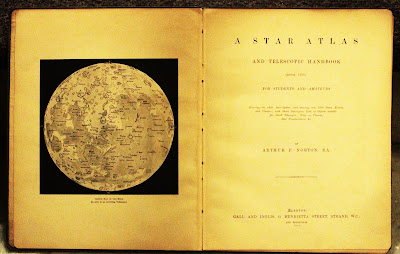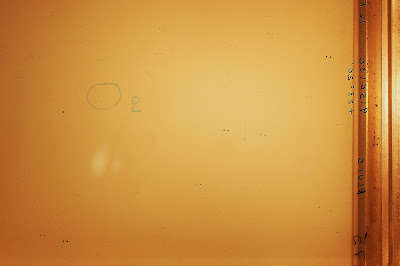Sitting on a set of cold hard marble steps, I paged through a 1910 version of Norton’s Star Atlas. The steps were far from comfortable but I wasn’t complaining. I was happy to be where I was.
It was Friday night and I was helping out as a volunteer for the Allegheny Observatory’s open house. My chore was to direct the various groups of visitors between the 13” Fitz-Clark refractor and the next stop, an explanation by some students of how the new Keeler scope was being used for research. I was positioned at the top of the three-story set of marble steps leading up to the telescope. Beside my perch was a small set of steps which I was using as a seat between tours.
At the top of these three steps was the entrance to the second balcony of the observatory’s library. Inside the door was a narrow balcony lined with books and journals. A thick pipe railing surrounded the opening. Three stories below was a gentleman describing and showing videos of the April total solar eclipse. Above was a glass ceiling. No light was coming through it but in my mind, the shelves were glowing!
After directing a group into the dome of the 13” refractor, I had about 20 minutes on my hands before the next group arrived. In those minutes, I talked with other volunteers and walked around a bit, peeking through windows to see what I could see. I also went into the library and explored the bookshelves!
The books on the third floor were a collection of various subjects. Placed in alphabetical order by author, I was taken for a journey between astronomy, the workings of light waves, the design and manufacturing of optics all the way into machine shop practices. There were also numerous volumes written in languages I couldn’t understand.
Being a machinist by trade I started out with a book about jigs and gages written in 1901. Books such as this are always fascinating to read. Having line drawings of old machinery and equipment, they are filled with lots of rich information which often isn’t passed on to new machinists these days. It is information which is usually picked up through years of experience. There are mentions and examples of tools and tooling which are no longer used in the modern machine shops because of the advancements of technology.
From there I headed into the field of astronomy. Since this library was in an observatory most of the books dealt in some way or another in that subject. I would remove a book from a shelf, being careful not to damage any fragile binding or covers, open it slightly and peruse the pages. If it interested me, I’d mark the spot it came from and go and sit down and read for a bit.
The Norton’s Star Atlas I mentioned before was one of the ones I had taken down. I have a copy of this book at home, written in 1989. I use it quite often. My copy was bought in 1990 and I had inscribed on the first page that the first observations using it was at 5AM on March 3rd, 1990. I was observing in Sagittarius. It also says, “It was a beautiful, warm morning, the way they all should be!” The 1910 version in the library was a lot thinner than my copy and it doesn’t have any of the glossy pictures that mine has but it does have the great sky maps.
I also looked at a book called “Astronomy by Observation” written by Eliza A. Bowen. Written in 1890 it has some photos of plaster reproductions of craters on the moon made by Nasmyth and Carpenter. Listed on its’ back cover are an assortment of scientific books ranging in price from 60¢ to $5. Sadly, the price of books has risen just the same as groceries.
I went in and listened to some of the talk about astronomy and the history of the 13” telescope. One of the stories told was about the time that the lens for the scope was stolen and held for ransom.
The telescope was built in 1861 by Henry Fitz and was installed in the original Allegheny Observatory. (It was later moved to its present location in the new observatory in 1906) When it was built it was the third largest telescope in the country! In 1872 the lens was stolen. A note demanded money but the observatory director, Samuel Langley wouldn’t pay. He figured this would only lead to more “lens-nappings”. The glass was eventually recovered in a hotel in Beaver Falls. The lens had a large scratch on it and it was shipped to Alvan Clark to refigure and polish. This ended up making the lens even better than it was before it was stolen! Ever since the lens has been replaced in the scope it has been known as the Fritz-Clark telescope.
Another book I looked at was called “The Elements of Theoretical and Descriptive Astronomy” written by Charles J. White. It was published in 1872. What makes this book special was that it had been owned by Samuel Langley! His signature was on the first page! To think I was holding a book once owned, signed and read by this important man was extremely exciting.
I get the same feeling when I think that John Brashear walked in these same corridors and climbed the same steps where I was stationed! This building is living history!
Once the last group had passed by I started saying my good-byes. I stopped in the basement and saw a glass negative taken using the 30” Thaw refractor. Just barely visible are two faint dots. This is a picture of the planet Pluto. The picture was taken on February 16th, 1953. This negative was taken 23 years after the planet was discovered. The reason there are two dots on the negative is that they would take a picture and then move the scope a slight bit and then take another shot. This was helpful in determining the exact position of the object they were observing. History, isn’t it exciting?
Talking with the people who run this facility, the students that do their studies and research here along with the various volunteers who helped pull this event off was a learning experience. There is so much to learn when talking with them; I can only hope that at least a little bit of their knowledge rubbed off on me!
I left the building without looking through either of the two telescopes that were being used. The clouds were making viewing difficult but most of the visitors saw Saturn and that is always something to remember! Even though I didn’t do any observing, as I headed home I had a feeling that in a small way I had participated in the history of this building and that I had been submerged into history itself. Old books, history and astronomy; what a wonderful combination!












.jpg)



1 comment:
An interesting evening
Post a Comment